A mandala tattoo is an ancient form of art and spiritual symbology that has been used for centuries as a tool for spiritual development and inner growth. The mandala is an intricate geometric design, usually a circle within a square, that symbolizes the universe and the interconnectedness of all things. It is a popular choice for tattoos due to its symbolic meaning and artistic beauty. If you’re interested in learning more about mandala tattoos and the spiritual symbolism they represent, read on to explore the spiritual symbology of this ancient art form.
Contents
What is a Mandala Tattoo?
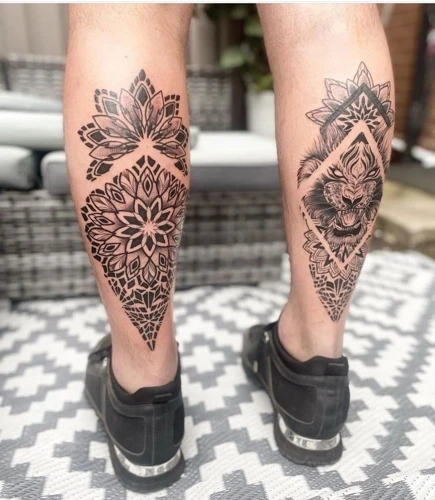
A mandala tattoo is an ancient spiritual symbol that originated in Hinduism and Buddhism. It is a circular design that is meant to represent the universe and its infinite cycles of creation and destruction. Mandala tattoos typically feature intricate geometric shapes, such as circles, squares, and triangles, and often incorporate elements of nature, such as flowers, trees, and animals.
The word “mandala” is derived from the Sanskrit word for “circle”, and it is believed that the mandala symbolizes the universe and its many life cycles. In Hinduism and Buddhism, mandalas are used as a tool for meditation and contemplation, to help focus the mind and bring about a deeper understanding of the spiritual realm.
The mandala is also thought to have a strong connection to the inner self, and it is believed that the mandala tattoo can be used to help the wearer gain a greater understanding of their own identity and spiritual path. A mandala tattoo can also be used to represent a connection to the divine or to honor a particular deity.
When it comes to mandala tattoos, the meaning of the design is ultimately up to the individual wearer. While some choose to use their mandala tattoo to explore their spiritual journey, others may use it to honor a loved one or to simply express their love for the beauty of the design. No matter what the meaning behind the mandala, it is a powerful and beautiful symbol that speaks to the soul.
What do mandala tattoos mean? Generally speaking, mandala tattoos represent the interconnectedness of all things and the spiritual journey of life. They are a reminder to be present and mindful, and to stay connected to the divine.
What Do Mandala Tattoos Represent?
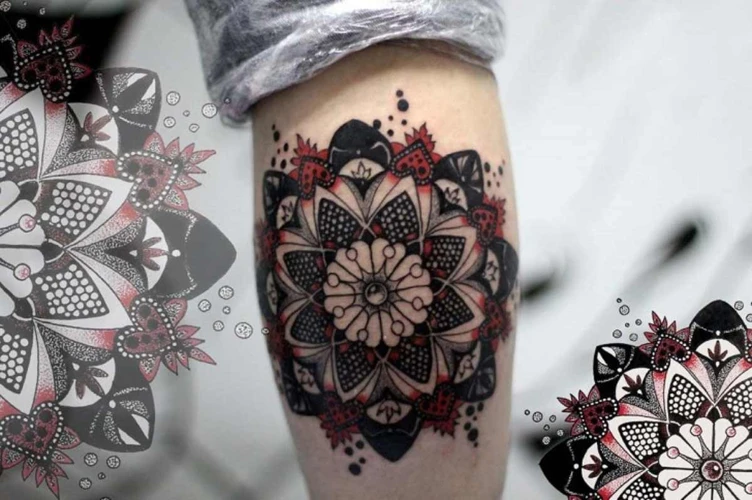
Spiritual Symbolism
Mandala tattoos are deeply symbolic and often represent a journey to enlightenment. The Sanskrit word “mandala” translates to “circle”, and the design is meant to represent wholeness, unity, and balance. The intricate patterns within the mandala tattoo often represent the interconnectedness of all things in the universe. In Buddhism, the mandala is thought to represent the journey to nirvana, while in Hinduism, it symbolizes the universe and the harmony of all its elements.
Ancient Art Form
Mandala tattoos are an ancient art form that have been used for centuries by Eastern religions and spiritual traditions. The mandala can be used as a tool for meditation and connecting with the divine, and the design is often used as a way to focus the mind and calm the spirit. The intricate patterns and colors of a mandala tattoo can be incredibly mesmerizing and are often used to invoke a sense of inner peace and harmony. For those looking for a tattoo that is both aesthetically pleasing and spiritually meaningful, a mandala tattoo is an excellent choice.
Mandala tattoos can also be used to symbolize the journey of life and the importance of living in the present moment. The mandala is often associated with the lotus flower, which is said to represent rebirth and the beauty of self-transformation. A lotus mandala tattoo can be used to symbolize the journey of self-discovery and the importance of embracing one’s own spiritual power.
What Does a Lotus Mandala Tattoo Mean?
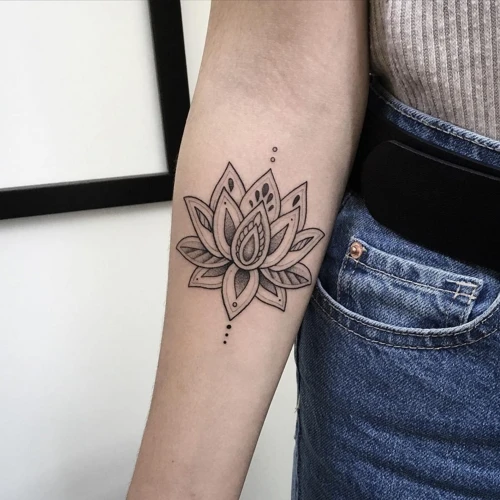
Lotus Flower Symbolism
The lotus flower is a powerful symbol associated with Buddhism and Hinduism. It is a reminder of the growth and transformation that comes from rising above the darkness and emerging into the light of consciousness. The lotus is also a symbol of purity and spiritual awakening, as it is able to rise above the murky waters and bloom into a beautiful flower. In tattooing, the lotus mandala is a powerful symbol, representing a journey of spiritual awakening and growth.
Spiritual Significance
A lotus mandala tattoo is a powerful symbol of spiritual growth and transformation. It represents the journey of emerging from darkness into the light of consciousness. It is a reminder to stay focused on the beauty and clarity that comes from rising above the pain and suffering of life. The lotus mandala is also a reminder to stay mindful and present in the moments of each day, allowing for spiritual transformation and growth. The lotus mandala is a powerful symbol of spiritual awakening and transformation.
Popular Mandala Tattoo Designs
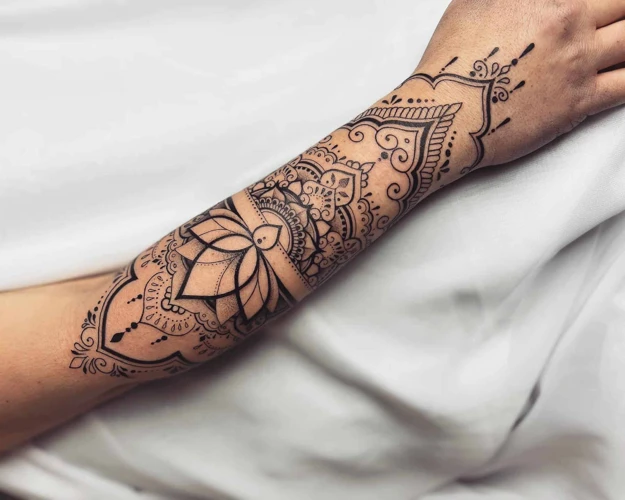
Geometric Patterns
Mandalas are circular designs that encompass complex geometric patterns and spiritual symbology. Traditional mandalas are drawn by monks and spiritual practitioners to aid with meditation. In the tattoo world, mandalas are often used to express a deep spiritual connection, enlightenment, and an appreciation for the beauty of the natural world. Popular mandala patterns often feature circles, squares, rectangles, and other geometric shapes arranged in a symmetric pattern. These shapes can be filled with intricate patterns, symbols, and vibrant colors.
Sacred Geometry
Sacred geometry is a core component of mandala tattoos. This ancient practice is based on the belief that the universe is made up of shapes and patterns that can be found in nature. Sacred geometry is commonly used to create mandala tattoo designs that feature repeating patterns of circles, squares, triangles, and other shapes that are connected in a symmetric pattern. These patterns are believed to represent the interconnectedness of all things and to bring balance and harmony to the wearer.
Placement Ideas for Mandala Tattoos
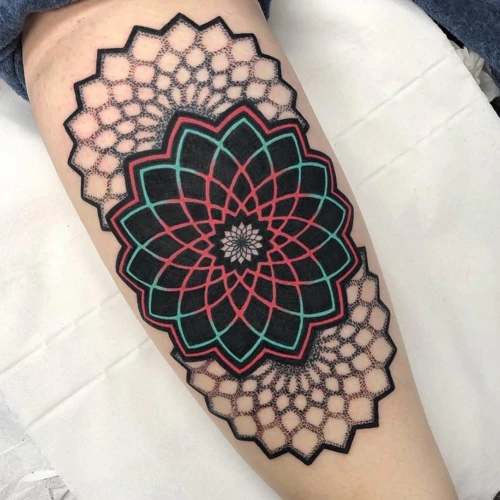
Mandala tattoos are versatile and can be placed in a variety of locations. The most popular placements are the upper arm, shoulder, back, and chest. The circular shape of the mandala looks great when wrapped around biceps, triceps, and other body parts. The design looks great when placed on the shoulder blade, and can be used as a canvas for a large intricate design. The chest is also a great place to display mandala tattoos, as it can be used to create a large colorful design. The back is another popular choice, as the entire body can be used to create a beautiful design that intertwines with the natural curves of the body. Mandalas also look great placed on the wrists, ankles, and the inner forearm.
Care and Maintenance of Mandala Tattoos
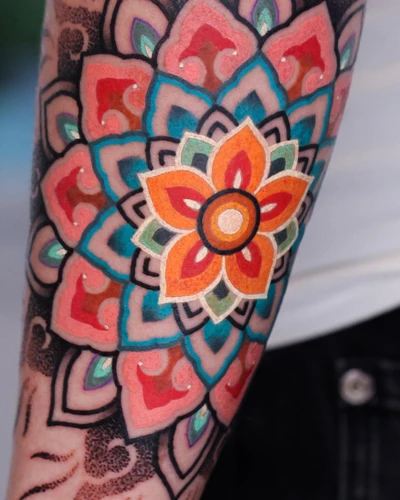
Mandala tattoos should be taken care of in order to maintain their color, vibrancy, and overall appearance. Here are the steps to take to ensure your mandala tattoo looks its best for years to come:
Before Healing
| Step | Description |
|---|---|
| Keep it Covered | Keep the tattoo covered for the first few hours after getting it done. |
| Clean it Gently | Clean the tattoo using a gentle soap and water. |
| Pat it Dry | Pat the tattoo dry with a clean paper towel. |
| Moisturize | Gently apply a thin layer of an unscented, hypoallergenic moisturizer. |
During Healing
| Step | Description |
|---|---|
| Avoid Water | Avoid long periods of swimming or soaking in water. |
| Don’t Pick | Do not pick or scratch at the tattoo as this can cause infection. |
| Be Gentle | Gently wash and pat dry the tattoo with a clean paper towel. |
| Moisturize | Apply a thin layer of an unscented, hypoallergenic moisturizer. |
After Healing
| Step | Description |
|---|---|
| Use Sunscreen | Use a sunscreen with an SPF of at least 30 when the tattoo is exposed to the sun. |
| Moisturize | Moisturize the tattoo with an unscented, hypoallergenic moisturizer. |
| Avoid Tanning | Avoid tanning beds and sun tanning to prevent fading of the tattoo. |
| Be Gentle | Gently wash and pat dry the tattoo with a clean paper towel. |
Following these steps will help ensure your mandala tattoo stays vibrant and beautiful for years to come.
Pros and Cons of Mandala Tattoos
- Pros:
- Mandalas are a beautiful form of body art that can be used to express your spiritual beliefs.
- They can be customized in various ways, from size to colors and designs.
- The simple design of a mandala can make a powerful statement.
- Mandalas are often seen as a representation of balance and harmony.
- The intricate patterns of a mandala can be a great conversation starter.
- Cons:
- Mandalas can be quite expensive to get tattooed.
- The complexity of the design can make them difficult to tattoo.
- Mandalas are typically large tattoos, so they require a larger area of the body.
- They can be more painful than other types of tattoos due to the intricate design.
- The design of a mandala may not be suitable for everyone.
Frequently Asked Questions
What is the History of Mandala Tattoos?
Mandala tattoos have their origins in Hindu and Buddhist religious art. They are usually circular designs which represent the universe and are used as a spiritual tool to aid in meditation. Mandalas were used in ancient times to help worshipers focus their thoughts on the divine. Over time, these designs have become popular among spiritual seekers and those looking for a unique tattoo. Mandalas can be used to express a variety of themes, from the cycle of life to spiritual balance.
What do Mandala Tattoos Represent?
Mandala tattoos are traditionally used to represent inner harmony, balance, and wholeness. As a spiritual symbol, it is believed to represent the universe and its cycles of life, death, and rebirth. The circular shape of the mandala is believed to represent the cycle of life and its connection to the divine. It can also represent cosmic unity and the connection between the material and spiritual worlds. Mandala tattoos are often used to symbolize personal growth, transformation, and spiritual journey.
How is a Mandala Tattoo Different from Other Types of Tattoos?
Design: Mandala tattoos feature intricate patterns and geometric shapes, which are different from other types of tattoos that may feature images or words.
Symbolism: Mandala tattoos often symbolize spiritual and religious beliefs, which is different from other tattoos that may symbolize something more personal or meaningful to the wearer.
Placement: Mandala tattoos are often placed on larger areas of the body, such as the back, chest, or arms. This allows for more intricate designs and larger patterns. Other tattoos may be placed on any part of the body, including smaller areas such as the wrist or ankle.
Colors: Mandala tattoos often feature bright and vibrant colors, while other tattoos may feature more muted tones.
Purpose: Mandala tattoos are often used for spiritual and religious purposes, while other tattoos may be for more personal or decorative purposes.
What are some of the most popular mandala tattoo designs?
-
1. Geometric Mandala Tattoos – These are some of the most popular designs for mandala tattoos, as they feature intricate geometric shapes and patterns. They can be combined with other symbols, such as stars, crescents, or circles, to create a more complex design.
2. Floral Mandala Tattoos – These designs feature flowers, petals, and other floral elements. They are often combined with geometric shapes, like circles, ovals, and triangles, to form a beautiful and unique mandala design.
3. Animal Mandala Tattoos – Mandala tattoos featuring animals are quite common. They can be combined with geometric shapes, like circles, ovals, and triangles, to create an intricate and symbolic design.
4. Spiritual Mandala Tattoos – These designs often feature spiritual symbols such as lotus flowers, sacred geometry, and yantras. They are often combined with geometric shapes to form an even more intricate design.
5. Abstract Mandala Tattoos – These designs are usually abstract and feature geometric shapes, symbols, and colors. They are often used to represent the wearer’s spiritual journey or spiritual beliefs.
Are there any risks associated with getting a mandala tattoo?
Mandala tattoos are generally a safe procedure, but as with any tattoo, there are some risks. Infection is one of the biggest concerns, but this can be minimized by choosing a reputable artist, sterilizing the area, and keeping the tattoo clean and dry. Allergic reactions can occur, particularly to the pigment or ink used in the tattoo, which may cause redness or itching in the area around the tattoo. Additionally, some of the chemicals used in the tattooing process, such as detergents, may cause skin irritation. If any of these side effects occur, it is important to seek medical attention immediately.
Conclusion
Mandala tattoos are an ancient art form with spiritual and symbolic meanings. From the traditional Tibetan sand paintings to modern interpretations, these tattoos provide a unique and beautiful way to express one’s beliefs and values. With its intricate designs and vivid colors, a mandala tattoo can represent the cycle of life, spirituality, and a connection to the divine.
References
- Overview of Mandalas (WebExhibits.org)
- Spiritual and Ceremonial Practices (National Park Service)
- Mandala (Boston College)